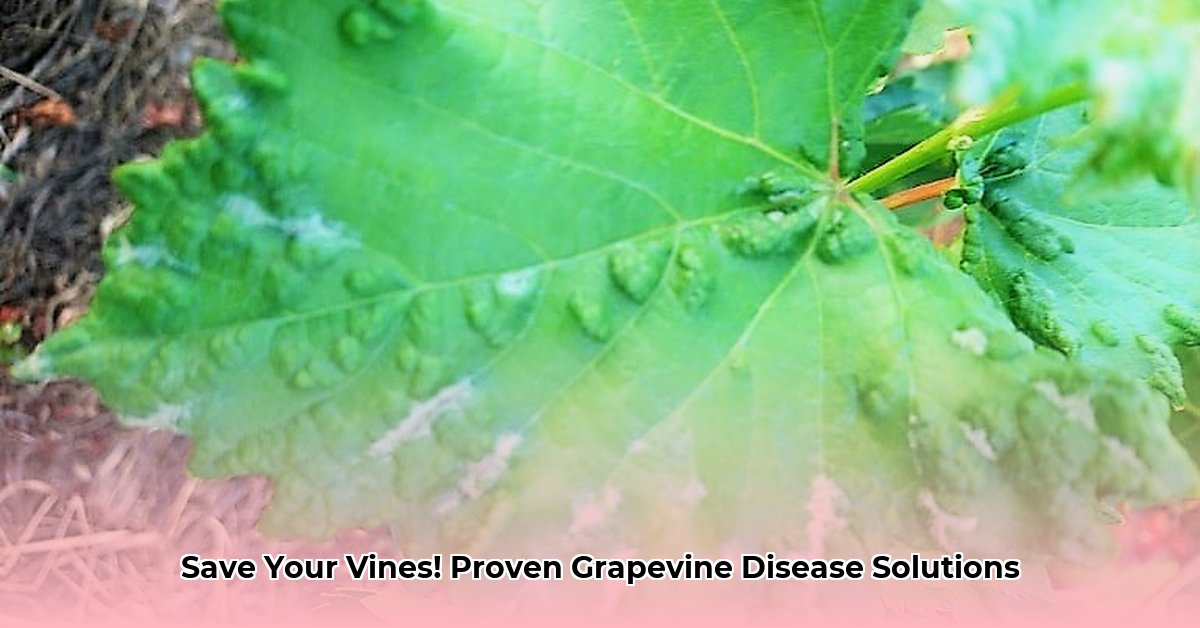Keeping your grapes healthy means battling diseases and pests—and doing it right is key to a good harvest and your bottom line. This guide gives you a practical, step-by-step plan to fight those vineyard villains using Integrated Pest Management (IPM). We’ll cover the big baddies—fungi, bacteria, viruses, and insects—showing you how to spot them and how to deal with them sustainably. You’ll learn about preventing problems before they start, using natural solutions, and when (and how) to use chemical controls safely. Whether you’re a pro or just starting out, this guide will give you the knowledge and tools to keep your vines healthy and your grapes plentiful, year after year.
Protecting Your Vines Through Integrated Pest Management and Sustainable Agriculture
Grape growing, the heart of winemaking, comes with its challenges. Pests and diseases are constant threats, but don’t let them spoil the harvest! This guide helps you protect your vines using Integrated Pest Management (IPM), a smart, sustainable approach that focuses on environmental protection while ensuring a bountiful yield. Let’s get started!
Understanding the Enemy: Identifying Grapevine Problems, Including Fungal Diseases and Insect Infestations
Several enemies can harm your vines. Fungal infections, like powdery mildew, downy mildew, Botrytis, and Phomopsis, are common. They create unsightly spots on leaves, damage fruit, and reduce your grape yield. Bacterial diseases, such as Pierce’s disease and crown gall, can be seriously damaging, affecting the vine’s vascular system and overall health. Viral infections, while less frequent, can also significantly impact your crop, leading to reduced vigor and fruit quality. On top of that, insect pests, from tiny leafhoppers and spider mites to the destructive phylloxera, add to the challenges.
The key is to identify these problems early. Regularly checking your vines is crucial; it allows you to quickly address issues before they spread. Early detection can improve treatment success rates significantly. Learn to recognize the telltale signs of each disease and pest:
- Powdery Mildew: White, powdery growth on leaves, shoots, and fruit.
- Downy Mildew: Yellowish spots on the upper leaf surface, with white, cottony growth on the underside.
- Botrytis (Grey Mold): Grey mold on grape bunches, especially during wet weather.
- Phomopsis Cane and Leaf Spot: Small, black spots on canes and leaves.
- Pierce’s Disease: Leaf scorch and dieback, eventually leading to vine death.
- Crown Gall: Tumors or galls at the base of the vine.
- Leafhoppers: Stippling or discoloration on leaves due to feeding.
- Spider Mites: Fine webbing on leaves, with small mites visible on close inspection.
- Phylloxera: Galls on roots, leading to vine decline.
Think of your vineyard like a garden – regular observation helps you spot problems before they become big headaches. Seeing even subtle signs early on makes a huge difference in how easily you can manage the situation. Keep detailed records of your observations, noting any unusual symptoms, the location of affected vines, and weather conditions. This information will be invaluable when making management decisions.
Preventative Steps: Setting the Stage for a Healthy Vineyard Through Proper Pruning, Vineyard Hygiene, and Soil Management
The best defense against grapevine diseases is a strong offense, starting with proactive vineyard management. Proper pruning lets air circulate better, reducing humidity, which helps prevent fungal growth. Good vineyard hygiene is just as important – this means promptly removing any infected plant material, including leaves, canes, and fruit, from the vineyard. Dispose of this material properly, either by burning or composting it away from the vines. Think of it like cleaning your house; you remove stuff that could cause problems.
Healthy soil is also essential. Conduct regular soil tests to determine nutrient levels and pH. Balanced fertilization and efficient irrigation strengthen the vines’ natural defenses, making them more resilient to disease and pests. Avoid over-fertilizing, as this can make vines more susceptible to certain diseases.
Choosing grape varieties and rootstocks that are naturally resistant to common ailments is another valuable preventative strategy. Select varieties that are well-suited to your local climate and soil conditions. Consult with local nurseries and agricultural experts to determine the best options for your vineyard.
By implementing these practices, you can significantly reduce your need for chemical intervention.
Integrated Pest Management (IPM): A Balanced Approach to Pest Control and Disease Management
IPM isn’t just a strategy; it’s a way of thinking. It combines different methods to manage pests and diseases, reducing reliance on harsh chemicals. It’s a holistic approach, using natural methods where possible and carefully considering when and how to use chemical controls.
1. Monitoring: Regularly inspect your vines, ideally on a weekly basis during the growing season. Look for signs of pests and diseases. Early detection is crucial for successful management. Use insect traps (e.g., pheromone traps for grapevine moths) and your own eyes; get to know your vines well enough to spot even subtle changes. The earlier you spot a problem, the easier—and less costly—it will be to resolve. Keep detailed records of your monitoring efforts, including the date, location, pest or disease identified, and severity of the infestation or infection.
2. Biological Control: Nature’s Helpers: Utilize nature’s power to fight pests with natural enemies. Introduce beneficial insects, like ladybugs (which prey on aphids), lacewings (which feed on various insect pests), and predatory mites (which control spider mites). Consider planting cover crops or flowering plants that attract beneficial insects to your vineyard. Biofungicides, naturally derived substances, can effectively control diseases without harming beneficial organisms within your vineyard. Bacillus subtilis and Trichoderma species are examples of biofungicides that can be used to control fungal diseases. It’s like having a natural army fighting for you.
3. Cultural Practices: In addition to pruning and vineyard hygiene, consider other cultural practices that can help manage pests and diseases. These include:
- Canopy Management: Proper canopy management improves air circulation and sunlight penetration, reducing humidity and disease pressure.
- Weed Control: Weeds can harbor pests and diseases, so effective weed control is essential.
- Water Management: Avoid over-watering, as this can create conditions that favor fungal diseases.
4. Chemical Control (As a Last Resort): Only use pesticides when other methods fail. Always follow label instructions carefully related to restricted use pesticides, paying close attention to application rates, timing, and safety precautions. Choose pesticides that are selective and have minimal impact on beneficial insects and the environment. Rotate your pesticides to prevent pests from building resistance. Think of it like switching up your cleaning products to prevent germs from adapting. This protects both your vines and the environment. Consult with local agricultural experts to determine the most appropriate pesticides for your specific situation.
Organic Control Methods: Harnessing Nature’s Power and Plant Extracts for Grapevine Protection
Organic methods provide a sustainable approach to disease and pest control. Compost tea improves soil health, while certain plant extracts can effectively combat specific pests and diseases.
- Compost Tea: Improves soil health and can suppress certain diseases.
- Neem Oil: Effective against a variety of insect pests and some fungal diseases.
- Bacillus thuringiensis (Bt): A biological insecticide that controls certain caterpillars.
- Copper-Based Fungicides: Used to control fungal diseases like downy mildew.
- Sulfur: Effective against powdery mildew and certain mites.
However, remember that organic methods might not always be completely effective or effortless; these techniques may require more monitoring and adaptation depending on disease pressure. The success often depends on factors beyond our control, such as weather patterns and timing.
Success Stories: Learning from Experience with Successful IPM Programs
IPM programs work worldwide, proving their adaptability across various climates. Vineyards in places like California, France, and Australia show that implementing a well-structured IPM program can lead to significant success. These programs often involve a combination of monitoring, biological control, cultural practices, and judicious use of pesticides.
Studying these successful examples provides valuable insights you can adapt to your own situation. Learn from others’ experiences and tailor your approach to your unique environment.
Your Actionable IPM Plan: A Step-by-Step Guide to Sustainable Vineyard Management
Short-Term Goals (0-1 year):
- Implement preventative cultural practices as outlined earlier, including proper pruning, vineyard hygiene, and soil management.
- Regularly monitor your vines for signs of pests or diseases, keeping detailed records of your observations.
- Employ biological controls, like beneficial insects, when appropriate.
- Use chemical pesticides judiciously, only as a last resort, focusing on low-impact options.
- Attend workshops or training sessions on IPM and sustainable viticulture.
Long-Term Goals (3-5 years):
- Develop a comprehensive IPM plan that addresses both short-term and long-term agricultural issues, tailored to your specific vineyard and climate.
- Consider integrating technology like precision viticulture, which allows for targeted interventions based on real-time data.
- Invest in disease-resistant grape varieties and rootstocks.
- Engage with local agricultural experts and other growers; share knowledge and experiences to strengthen best practices.
- Track your progress and make adjustments to your IPM plan as needed.
Resources: Expanding Your Knowledge on Sustainable Grape Growing
Stay informed! Your local agricultural extension office is a fantastic resource. They often
- Japanese Lunch Bag Does Double Duty as Bento Carrier and Tote - December 4, 2025
- Your Perfect Bento Box Bag For Fresh And Tidy Meals - December 2, 2025
- Korean Meal Prep Made Easy For Delicious Weekday Meals - December 1, 2025










